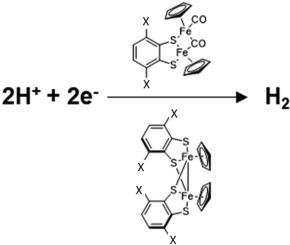International Journal of Hydrogen Energy ( IF 8.1 ) Pub Date : 2020-09-15 , DOI: 10.1016/j.ijhydene.2020.08.237 Wen Liang James Loke , Wai Yip Fan

|
The UV photolysis of cyclopentadienyl iron dicarbonyl dimer [CpFe(CO)2]2 and benzene-1,2-dithiol or 3,6-dichloro-1,2-benzenedithiol afforded dinuclear iron complexes [Cp2Fe2(CO)(bdt)(μ-CO)] (1) and [Cp2Fe2(CO)(Cl2-bdt)(μ-CO)] (2) respectively (bdt = benzene-1,2-dithiolato, Cl2-bdt = dichloro-1,2-benzenedithiolato). Further oxidation of the two complexes resulted in the release of CO and generated [CpFe(bdt)]2 (3) and [CpFe(Cl2-bdt)]2 (4). All four complexes were found to catalyse proton reduction at a similar overpotential and rate when trifluoroacetic acid (TFA) was used as a proton source. Both experimental and computational studies lent support to a mononuclear iron intermediate species carrying the CpFe(bdt) or CpFe(Cl2-bdt) moiety acting as the catalyst in the proton reduction process.
中文翻译:

质子还原使用环戊二烯基Fe(II)(苯-1,2-二硫代巯基)羰基配合物作为电催化剂
环戊二烯基铁二羰基二聚体[CpFe(CO)2 ] 2和苯1,2-二硫醇或3,6-二氯-1,2-苯二硫醇的紫外光解得到二核铁配合物[Cp 2 Fe 2(CO)(bdt) )(μ-CO)](1)和[Cp 2 Fe 2(CO)(Cl 2 -bdt)(μ-CO)](2)分别(bdt =苯-1,2-二硫代拉托,Cl 2 -bdt =二氯-1,2-苯二硫基。两种复合物的进一步氧化导致CO的释放并生成了[CpFe(bdt)] 2(3)和[ CpFe (Cl 2 -bdt)] 2(4)。当将三氟乙酸(TFA)用作质子源时,发现所有四个复合物均以相似的超电势和速率催化质子还原。实验研究和计算研究均对带有CpFe(bdt)或CpFe (Cl 2 -bdt)部分作为质子还原过程中的催化剂的单核铁中间体提供了支持。











































 京公网安备 11010802027423号
京公网安备 11010802027423号